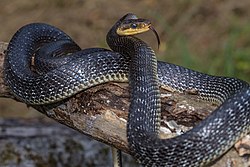змей
Bulgarian
Etymology
From Proto-Slavic *zmьjь. The meaning dragon is likely secondary, evolved from an earlier snake, reptile or more generally a creature that dwells on the ground. From the same root as Bulgarian земя́ (zemjá, “earth, ground”) (е-grade), derived through 0-grade ablaut and the suffix -ей (-ej).
Pronunciation
Noun
змей • (zmej) m (feminine змеи́ца, relational adjective зме́йски)
- dragon (usually a male one)
- (figuratively) kite
Inflection
| singular | plural | |
|---|---|---|
| indefinite | змей zmej |
зме́еве, зме́йове zméeve, zméjove |
| definite (subject form) |
зме́ят zméjat |
зме́евете, зме́йовете zméevete, zméjovete |
| definite (object form) |
зме́я zméja | |
| count form | — | зме́я zméja |
| vocative form | зме́ю zméju |
зме́еве, зме́йове zméeve, zméjove |
Related terms
- змия́ (zmijá, “snake”)
References
- “змей”, in Речник на българския език (in Bulgarian), Sofia: Bulgarian Academy of Sciences, 2014
- “змей”, in Речник на българския език (in Bulgarian), Chitanka, 2010
Komi-Zyrian

Etymology
Borrowed from Russian змей (zmej).
Pronunciation
Noun
змей • (zmej)
Declension
| singular | plural | ||
|---|---|---|---|
| nominative | змей (zmej) | змейяс (zmejas) | |
| accusative | I 1 | змей (zmej) | змейяс (zmejas) |
| II 1 | змейӧс (zmejös) | змейясӧс (zmejasös) | |
| instrumental | змейӧн (zmejön) | змейясӧн (zmejasön) | |
| comitative | змейкӧд (zmejköd) | змейяскӧд (zmejasköd) | |
| caritive | змейтӧг (zmejtög) | змейястӧг (zmejastög) | |
| consecutive | змейла (zmejla) | змейясла (zmejasla) | |
| genitive | змейлӧн (zmejlön) | змейяслӧн (zmejaslön) | |
| ablative | змейлысь (zmejlyś) | змейяслысь (zmejaslyś) | |
| dative | змейлы (zmejly) | змейяслы (zmejasly) | |
| inessive | змейын (zmejyn) | змейясын (zmejasyn) | |
| elative | змейысь (zmejyś) | змейясысь (zmejasyś) | |
| illative | змейӧ (zmejö) | змейясӧ (zmejasö) | |
| egressive | змейсянь (zmejśań) | змейяссянь (zmejasśań) | |
| approximative | змейлань (zmejlań) | змейяслань (zmejaslań) | |
| terminative | змейӧдз (zmejödź) | змейясӧдз (zmejasödź) | |
| prolative | I | змейӧд (zmejöd) | змейясӧд (zmejasöd) |
| II | змейті (zmejti) | змейясті (zmejasti) | |
1 Animate nouns almost exclusively take the type II accusative ending, whereas inanimate nouns can be used with either ending, but are more often found with type I.
1 Animate nouns almost exclusively take the type II accusative ending, whereas inanimate nouns can be used with either ending, but are more often found with type I.
1 Animate nouns almost exclusively take the type II accusative ending, whereas inanimate nouns can be used with either ending, but are more often found with type I.
1 Animate nouns almost exclusively take the type II accusative ending, whereas inanimate nouns can be used with either ending, but are more often found with type I.
1 Animate nouns almost exclusively take the type II accusative ending, whereas inanimate nouns can be used with either ending, but are more often found with type I.
1 Animate nouns almost exclusively take the type II accusative ending, whereas inanimate nouns can be used with either ending, but are more often found with type I.
| ||||||||||||||||||||||||||||||||||||||||||||||||||||||||||||||||||||||||||||||||||||||||||||||||||||||||||||||||||||||||||||||||||||||||||||||||||||||||||||||||||||||||||||||||||||||||||||||||||||||||||||||||||||||||||||||||||||||||||||||||||||||||||||||||||||||||||||||||||||||||||||||||||||||||||||||||||||||||||||||||||||||||||||||||||||||||||||||||||||||||||||||||||||||||||||||||||||||||||||||||||||||||||||||||||||||||||||||||||||||||||||
References
- A. I. Podorova, editor (1948), Коми-русский словарь , Syktyvkar: Коми Государственное Издательство, page 80
- L. M. Beznosikova, E. A. Ajbabina, R. I. Kosnyreva (2000) Коми-русский словарь , →ISBN, page 226
Russian
Pronunciation
Etymology 1
Inherited from Proto-Slavic *zmьjь. Doublet of змий (zmij), a borrowing from Old Church Slavonic.
For the “kite” sense, compare New Latin draco volans (literally “flying dragon”), German Drachen (literally “dragon”), French cerf-volant < Old French serpe volant (literally “flying serpent”).
Alternative forms
- змѣй (změj) — Pre-reform orthography (1918)
Noun
змей • (zmej) m anim or m inan (genitive зме́я, nominative plural зме́и, genitive plural зме́ев)
- (dated, mythology or biblical) serpent (snake)
- Synonym: змея́ (zmejá)
- (mythology) serpent, dragon (legendary serpentine creature)
- Synonym: драко́н (drakón)
- (figuratively) snake (crafty, wily, evil man)
- kite (flying toy)
- Synonym: возду́шный змей (vozdúšnyj zmej)
Declension
Related terms
- возду́шный змей (vozdúšnyj zmej)
- зелёный змий (zeljónyj zmij)
Descendants
- → Komi-Zyrian: змей (zmej)
See also
Etymology 2
Noun
змей • (zmej) f anim pl
- genitive/accusative plural of змея́ (zmejá)

